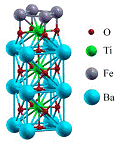Department of Physics and Astronomy: Publications and Other Research
Date of this Version
4-10-2018
Citation
PHYSICAL REVIEW B 97, 155121 (2018).
DOI: 10.1103/PhysRevB.97.155121
Abstract
Motivated by recent experimental observations, we explore electron transport properties of a ferroelectric tunnel junction (FTJ) with an embedded head-to-head ferroelectric domain wall, using first-principles density-functional theory calculations. We consider a FTJ with La0.5Sr0.5MnO3 electrodes separated by a BaTiO3 barrier layer and show that an in-plane charged domain wall in the ferroelectric BaTiO3 can be induced by polar interfaces. The resulting V-shaped electrostatic potential profile across the BaTiO3 layer creates a quantum well and leads to the formation of a two-dimensional electron gas, which stabilizes the domain wall. The confined electronic states in the barrier are responsible for resonant tunneling as is evident from our quantum-transport calculations. We find that the resonant tunneling is an orbital selective process, which leads to sharp spikes in the momentum- and energy-resolved transmission spectra. Our results indicate that domain walls embedded in FTJs can be used to control the electron transport.


Comments
Copyright 2018 American Physical Society. Used by permission.